

 |
||
 |
||
Vol. 7 (2): November 2004 |
Download this page
|
|
Greece / Italy / Madeira / Mauritania & Western Sahara / Morocco / Turkey
Italy
|
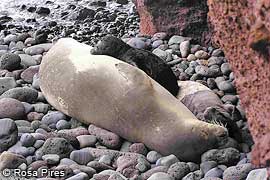 |
|
|
Tabaqueiro beach, Desertas Islands. |
With the monk seal pupping season peaking in October/November, our monitoring of the breeding area intensified. Three births occurred in the beginning of November. Sadly, one of these pups, still showing its umbilical cord, died. The necropsy was not conclusive but several injuries on its body suggest that the young seal may have been dashed against the rocks in stormy weather. This is one of the primary threats for this population since the birth season coincides with the season when sea storms are most frequent.
This year the females and the pups are again using Tabaqueiro beach and, observing the group of seals there, we could detect a new breeding female [see One pup – three “mothers”, TMG 7(1): 2004].
On Madeira island, we are organising a public opinion survey to discover what Madeirans think about the monk seal’s return to their island, and also to gauge their level of knowledge of the species. – Rosa Pires, Parque Natural da Madeira.
Parque Natural da Madeira. 2003. Help us to help the monk seal. English brochure and sighting register: 1-2.
[![]() 1.3MB]
1.3MB]
In September this year, the carcass of the rehabilitated seal ‘Weam’ was found on a beach at the Cabo Blanco peninsula, about 15 km south of the breeding caves. A year and a half had passed since we lost track of her movements [see Weam is one year old, TMG 5 (2): November 2002 and Rescue, release and post-release monitoring of Weam, TMG 5 (1): May 2002].
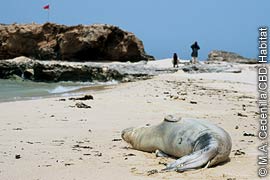 |
|
|
Remembering better times: Weam monitored by guards in the Coast of the Seals reserve. |
She was rescued by members of the CBD-Habitat Foundation in September 2001, during a storm when she was three days old. She was rehabilitated in the facilities of the Mauritanian Institute of Oceanographic and Fisheries Research (IMROP) in collaboration with the SRRC of Pieterburen. The process lasted five and a half months. She was released 27 February 2002 at the beach known as “Barco de azúcar”, two kilometres away from the breeding caves and inside the reserve of the Coast of the Seals [see Conservation actions on the Cabo Blanco peninsula – a new approach, TMG 5 (2): November 2002].
After the release, she was tracked and monitored by the CBD-Habitat team through direct observation as well as by satellite. During the first months she used the beaches of the western coast of the Cabo Blanco peninsula and even made movements that allowed her to reach the National Park of Banc D’Arguin.
After two months, she became accustomed to hauling out on open beaches near the release site, where she also had effective protection by the surveillance patrol. This was good news and also offered hope that other members of the colony would begin to imitate her and use open beaches, thus beginning a re-adaptation to the original resting and reproductive habitat of the species. In an occasional manner, but with some periodicity, Weam would use a different beach at the south, outside the protected reserve area. This was where her carcass was eventually found.
On 25 February 2003, we saw her alive for the very last time. During the following year and a half we didn’t have any news of her despite periodic coastal inspections and interviews conducted with every person we could find at the beaches.
Then last September, during one of these coastal inspections, a half-buried corpse in the sand that the wind had exposed alerted us. Immediately we realized that it was a monk seal carcass, and knew it was Weam as soon as we found one of the identity tags we had applied to her rear flipper. She had suffered a broken skull, had been opened with a knife in the ventral area, and someone had removed all the meat and fat. The carcass had been well buried to avoid detection, and it clearly seemed that someone had killed her to benefit from the meat and fat.
Two conclusions and one recommendation can be obtained from this incident:
On the one hand, it is necessary to draw attention to the spectacular demographic growth of the nearby city of Nouadhibou that has caused a significant increase in human pressure over the area surrounding the Coast of the Seals Reserve. This fact leads us to think that if this phenomenon continues, the future expansion of the monk seal will be in the northern area of the Cabo Blanco peninsula.
On the other hand, it is necessary to emphasize that Weam displayed strong docile behaviour, as a consequence of her habituation to humans during the rehabilitation process. When she was returned to the wild, she never showed any sign of fear of human presence, nor any impulse to escape. This behaviour was almost certainly responsible for the capture and death of the seal. Her presence was known and respected by local fishermen who would fish on the coast, who could even touch her while she was sleeping.
Taking these facts into account we believe that to avoid in the future incidents of this kind, rehabilitation protocols should be reviewed in order to minimize human contact with seals. If that is not possible, then an acclimatization process should be included in order to modify such docile behaviour towards humans. – Miguel Ángel Cedenilla and Pablo Fdez. de Larrinoa, Fundación CBD-Habitat.
Last September, the presidents of CBD-Habitat Foundation and the Moroccan NGO Nature Initiative signed a collaboration agreement in order to jointly develop conservation actions for the monk seal and other threatened species in the region of the south of Morocco, in the former Spanish Sahara.
Such an agreement is the consequence of dialogue and staff exchanges undertaken during this last year between both associations.
One of the first actions performed has been to begin the exploration of the coast south of Cap Barbas, in order to determinate the status of monk seals in the area, currently unknown. Two short expeditions already performed with the Royal Navy and the Institute of Research of Marine Resources (INRH) allows us to have some hope regarding the positive presence of monk seals along this coast. Information campaigns are being designed to inform artisanal fishermen and military authorities about monk seals and their endangered status in the area. In a complementary step, we are already working on the installation of a permanent surveillance patrol and of a monitoring station in the area, as well as a series of actions to improve fishermen’s quality of life and the promotion of sustainable fisheries in the area, avoiding the use of trammel and gill nets.
Under this collaboration framework, CBD-Habitat with Nature Initiative and the INRH have already edited a school booklet for the kids of Dakhla.
All the actions that will be developed are taken from the recommendations of the Action Plan for the Recovery of the Monk Seal in the Eastern Atlantic, adopted by the four countries of the species’ range in the Atlantic, Spain, Portugal, Morocco and Mauritania. – Pablo Fdez. de Larrinoa and Miguel Angel Cedenilla. Fundación CBD-Habitat.
From 12-15 October, the third meeting of the Working Group coordinating the Monk Seal Recovery Plan in the Eastern Atlantic was held in the city of Dakhla.
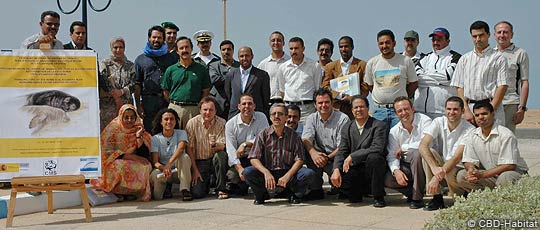 |
|
Working Group participants gather in Dakhla to advance the Monk Seal Recovery Plan in the Eastern Atlantic. |
The General Secretary of Marine Fisheries of Morocco and the General Director of the Research Institute of Marine Resources opened the proceedings. The meeting allowed the Working Group to determine whether to pursue the recommendations established at the PHVA workshop held in Valsain, Spain in 2002 [see International workshop report issued, TMG 5 (2): November 2002 and International workshop wrestles with Atlantic issues, TMG 5 (1): May 2002]. The Deputy Executive Secretary of the Convention of Migratory Species (Bonn Convention), Mr. Lahcen El Kabiri, assisted the meeting, which was convened and organized by the Ministry of Environment of Spain and the Institute of Research of Marine Resources of Morocco. CBD-Habitat Foundation participated in the meeting’s coordination as well as in the preparation of all working documents used during the sessions.
Apart from the members of the Working Group (coming from Portugal, Morocco, Spain and Mauritania), the meeting was also attended by many participants and guests from the local and regional civil and military authorities, as well as representatives of various NGOs and Moroccan agencies involved (Ministry of Water and Forests, National Office of Fisheries, etc.).
The representatives of the range states approved the technical document of the Plan and elaborated a document named the “Dakhla Declaration”, which apart from technically approving the Plan, also calls for international assistance in funding it and for support for Morocco’s initiative to create a marine protected area for monk seal conservation and to apply a management plan for a future national park in the area.
After the meeting, some members of the delegations travelled to Mauritania with the representatives of CBD-Habitat Foundation, to visit the Cabo Blanco monk seal colony and to enjoy viewing the 14 pups that were present in the breeding caves at that moment. – Pablo Fdez. de Larrinoa and Miguel Angel Cedenilla. Fundación CBD-Habitat.
The Fondo para la Foca del Mediterráneo (FFM) undertook a monk seal survey along the Mediterranean coasts of Morocco in August, reports Xisco Avella, and all signs were negative. The animal FFM researchers were accustomed to seeing in the same spot is now dead, its corpse having appeared on a beach last spring (FFM received dozens of communications confirming the event).
In the Chafarinas archipelago, probably for the first time ever, there was not one recorded monk seal observation during the current year. This seems to indicate that the minute population that survived on the neighbouring mainland coast has now been eradicated.
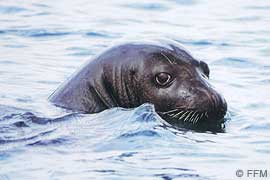 |
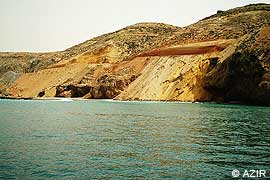 |
|
|
The seal well-known to FFM researchers was found dead in spring. |
The new coast road now cutting through monk seal habitat. |
Most worrying of all, adds Avella, a huge alteration of habitat is now underway in the form of a main road, being built to join Saidia (near the Algerian border) and Tanger (in the Straits of Gibraltar). At some places, this only involves enlarging an existing old and narrow road, far away from the seaside, but in others – in some of the wildest remnants of Morocco’s Mediterranean coast, and around the site once frequented by the seal found dead in spring – an entirely new road is being built. This involves construction over sea cliffs and seaside slopes, with debris being thrown down to the sea, in some cases even burying marine grottoes.
After 15 years of public awareness activities in the area, reports Avella, the latest developments in Mediterranean Morocco are hard to accept.
Mediterranean News continues with Turkey...
Copyright © 2004 The Monachus Guardian. All Rights Reserved |